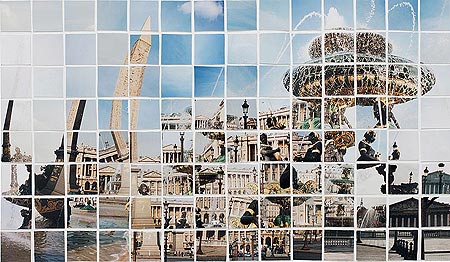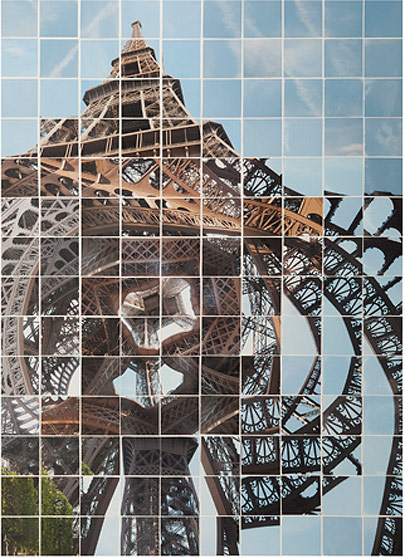| ORIGINS |
 |
Johanna Pernot is influenced by the Cubists’ experiments as well as David Hockney’s Polaroid portraits. She first discovered Hockney through his Grand Canyon paintings at the Royal Academy of Arts. Her work is primarily a contemplation of how “space and time are pure (a priori) intuitions, and are subjective conditions of the sensibility which establish a foundation for all other intuition”. She focuses on monuments and places which she deconstructs and rearranges by using multiple perspectives and distances in the same piece.
Johanna Pernot unflinchingly breaks open and dismantles her subject, not by circling around it, but by plunging deep within. So we find ourselves invited to penetrate its essence. The artist does not reproduce a scene through fragmentation in order to reflect on the function of the human eye, but does it rather to interpret and appropriate the subject.
She turns the reality that surrounds her into a substance, which she then molds and transforms to create a new atmosphere or story.
|
 |
METHOD
Squares
|
 |
......................................................................................................................................
The photo collages are mosaics made up of square-shaped photographs. The artist chooses each photo from about a hundred and then cuts and shapes it manually. In a way, each square in the collage functions like a pixel in a digital image. |
 |
 |
| Time |
 |
The photos that make up some of the collages are taken at different moments of the day, even on different days altogether. By doing this, the artist plays with exposure and lighting conditions like Monet did when he painted The Thames at Westminster or the Rouen Cathedral. Even though the light in a painting or a photograph is linked to the moment in time the work was executed, the variety of photos in a collage allows for the juxtaposition of different moments, creating variations in light and weather conditions within one single work.
|
 |
 |
|
|
 |
|
|
 |
| ........................................ |
 |
| Rain, sun, and fog all mingle together in Halong Bay |
|
 |
 |
|
Space
|
 |
Each photo collage focuses on the characteristics of a specific location—be it a natural landscape or an urban setting. The use of a diverse variety of photographs means several angles can be incorporated into the representation of a single scene, thereby overcoming the limitation of the human eye and giving the observer a 360° view.
|
 |
 |
 |
|
|
 |
|
|
 |
| ........................................ |
 |
| The National Assembly and the Madeleine Church—in reality on opposite sides of Paris—are side by side on this “new” Place de la Concorde. |
|
 |
|
 |
Several different shots and compositions in one collage equal several points of view. As in Cubist paintings, the viewer’s eye is ensnared and forced to wander within an image that the mind strives in vain to recognize. The disjointed perspectives and distances force the viewer to travel around and reinvent the location for himself.
|
 |
 |
 |
|
|
 |
 |
This location, which is by definition stationary—which would be frozen in a normal photograph—here, generates its own momentum. The coexistence of different angles and focal lengths sets the subject in motion, like this “dancing” Eiffel Tower.
|
|
|
|
 |
| ........................................ |
 |
| French Cancan |
|
 |
|
The grid
|
 |
The white lines that separate the squares in the collage play an important role in this dynamic. They break up the continuity of the image and force the mind to bridge the spaces between the squares. So it’s not an empty space, but rather an ellipsis—a blank—that the imagination is forced to subconsciously fill in. In addition, the flexible arrangement of squares allows for a creative redistribution of space. Spatial layout, monument and building outlines are rarely respected—a tower can float in the air, replicate itself, or lean dangerously (The Babel of Shanghai). These departures from the laws of perspective and gravity mean that various different themes can coexist in a single collage. What is more, breaking these rules of art is an expression of freedom striving to create meaning.
|
 |
 |
THE CONSTRUCTION OF MEANING
“Nothing will take place but place itself” (Mallarmé)
|
 |
......................................................................................................................................
What is the point of altering the parameters of time and space? There are several objectives—some of them contradicting—at play here.
|
 |
 |
|
The first
|
 |
one is aesthetic—an attempt to embrace the fleeting beauty of a motif or a place, to “add up” all the squares together, with each individual square striving to capture a sliver of the beauty.
|
 |
 |
|
The second
|
 |
objective is ontological. Playing with spatial and temporal parameters enables the constant to emerge. The constant is what lies beyond accidents and differences. In a way it’s the essence—what makes the place or the motif what it is.
So Halong Bay, seen in all weather conditions, incorporates everything—far off corners, the mountains, the sea, the boarding of boats, a fishing village—in an attempt to grasp the unity of this microcosm, its harmony and untouched grace, beyond time and civilization.
|
 |
 |
 |
|
|
 |
 |
Similarly, the Amsterdam collage blends together several scenes and motifs (the bridge, window, lamp, bike, boat…) of the Venice of the North to provide an ideal image.
|
|
|
|
 |
| ........................................ |
 |
| Amsterdam |
|
 |
|
The collage as an allegory
|
 |
Lastly, the piece can function as an allegory. The overall image secretly tells a story—an imagined metaphor, created line by line through inspiration and luck.
|
 |
 |
|
SOME HINTS…
|
 |
......................................................................................................................................
French Cancan is not just a flat representation of the most famous monument in Paris. This traditionally phallic symbol is feminized here. The tower dances, the ruffles of her frilly dress swirling around her legs where the lewd-minded observer can discover an Iron Lady dancer with legs spread wide open. Images and fantasies are overlapped to represent Paris and the eroticism that the city embodies in our collective imagination.
|
 |
 |
 |
|
 |
Blow up is a photo collage of the Tuileries Garden in Paris.
|
 |
 |
|
|
 |
 |
|
|
As with Antonioni’s film Blow Up, this collage can be read as an allegory about photographic and artistic creation.
To this end, as the three bronze statues in the left foreground move across the lawn they become the three graces, dancing in the middle of the image. The triangular lawn only looks empty. It’s actually hiding three small pedestals, as well as the photographer’s shadow. In fact, it is in this space that the invisible magic of art takes place. By walking off their foundations the bronze statues become transformed into a work of art once they attain the large pedestal. The greenish pool on the right unveils the process of this transformation because it is actually the photographer’s developing tank. So we could say that Blow up represents the trinity of art: reality (the black statues), art as the transformation of reality (the black statues become white), and the artist (the unseen photographer developing negatives in his tank).
|
 |
 |
|
|
 |
 |
|
|
I and the Eye was inspired by sculptor Anish Kapoor’s work exhibited at the Grand Palais for La Monumenta 2011.It shows Man’s confrontation with the universe. In spite of the fact that it’s located in the foreground the leaning figure of the I is tiny and risks being crushed by the expansion of space and time. Nevertheless, in this terrifying face-to-face with infinity and emptiness, I is the one that dares turn his back on the reassuring world that Man has built (the emergency exit on the left being the path of blindness and denial) in an attempt at understanding a mystery which he has only scratched the surface of.
|
 |
 |




